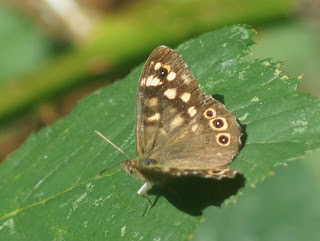Despite it only being a short visit to Cranford Park yesterday, I came home quite excited and looking forward to writing up my blog because I had two new patch ticks. Unfortunately my home internet decided to crash, so I am now writing this on a Sunday morning from the comfort of the local Weatherspoons, The Botwell, and would like to say big thanks to the helpful staff who had my new wifi account up and running in minutes.
So back to yesterday, the butterfly transect walk really showed the season is slowing down despite the temperature being in the 20's and the sun shining for most of my visit.
Yesterdays tally:
1 Green-veined White
4 Red Admiral
6 Speckled Wood
Just 11 butterflies of 3 species.
It's that time of year again when I get distracted by various fungi popping up everywhere.
The Stagshorn is spreading nicely, with another small clump found....
I think the one below is one of the Bolete species, but don't quote me on that. It was the size of my hand and light purple brown....
The Dead Mans Fingers have really spread well this year. I've now found six old logs that have this fungus on them, compared to last year when I only found two.....
I found my first Coral fungus of the year yesterday. Normally I find this edging one of the woodland paths, but this fine clump was growing up a pile of stacked logs.....
But my find of the day, and a first for me at Cranford Park, was this stonking Stinkhorn.
The fungi starts off as an almost buried grey white coloured 'egg'. When the conditions are right a spongy white shaft erupts. The top of the shaft is covered in slime where the spores are and the fungus often smells quite putrid. The smell is to attract flies, which land on the slime then take off with the spores stuck to their feet. The flies will then go somewhere else, therefore spreading the spores and the Stinkhorn naturally reproduces.......
My other patch tick today was the discovery that Cranford Park has Ivy Bees visiting. As the name suggests they only feed on flowering ivy, and are only seen between September to mid November. I have never seen Ivy Bees at Cranford Park before, so this is very exciting for me. This species of mining bee nests in loose soil on the ground. The Ivy Bee is harmless, and very rarely stings - in fact to get stung by an Ivy Bee you would have to pick up a female (the males don't sting at all) and physically squeeze the bee. Despite all the patches of flowering ivy at the park at the moment, I only found the Ivy Bee on one short section by the M4 wall. This stunning bee, with its furry thorax and stripy body, was only first recorded in the UK in 2001 so each year records are asked to be noted on the BWARS website (link here to the mapping project). I have added my records and will now be looking to see if I can spot a ground nest nearby......
I also found a new gall today. I've seen these before but never really registered what they are. They are Silk Button Galls and only found on the underside of English Oak leaves....
Yesterdays weather was dry, with good bursts of sunshine but a little windy. Hence the Common Darters were mainly found resting on the ground....
or as in yesterdays case, perched atop the wooden posts surrounding the orchard.....
Several species of hoverfly were around but the most prolific was the Myathropa florea, one of the most instantly recognised hover due to the 'batman' symbol on its thorax.....
As I was leaving I checked the green metal gates for any more Harlequin ladybirds and found one larva, one pupa and three recently emerged adults. Their season is not yet over....
Very chuffed with the two new patch ticks - the Stinkhorn and the Ivy Bee - and wondering what other surprises Cranford Park has before the year is out.
































No comments:
Post a Comment